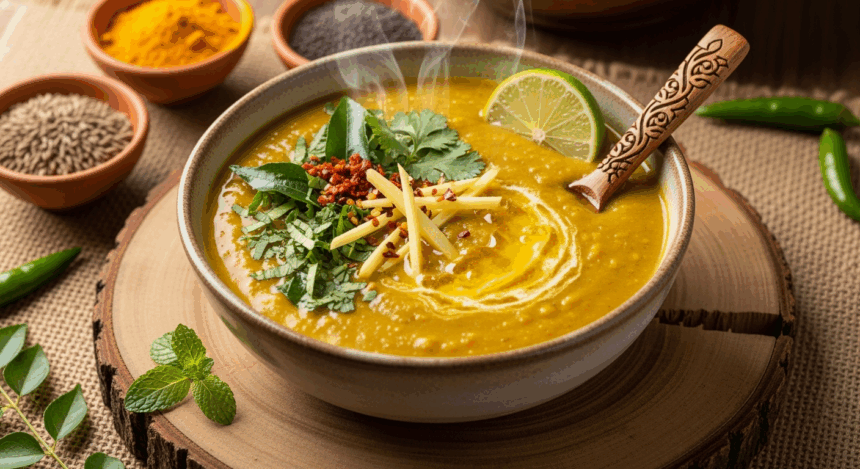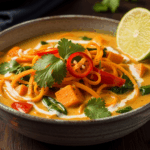Picture this: it’s a chilly evening, you’re wrapped in your favorite blanket scrolling mindlessly through social media, when suddenly your stomach growls louder than your neighbor’s questionable taste in music. You need something warming, nourishing, and ideally something that won’t have you washing dishes until midnight. Enter: Ayurvedic Mung Bean Lentil Soup – the centuries-old recipe that’s about to become your modern-day comfort food hero!
Why This Recipe is Awesome
Let’s get real for a second. This isn’t just any soup – it’s practically a warm hug in a bowl with bonus healing powers. Ayurvedic cooking has been around for like, thousands of years, which means this recipe has outlasted countless food trends, several empires, and all nine seasons of The Office.
The best part? It’s virtually impossible to mess up. Seriously, if you can boil water without creating a small kitchen fire, you’re already 80% of the way there. Plus, this soup is:
✅ Incredibly balancing for all doshas (that’s Ayurvedic speak for “good for pretty much everyone”)
✅ Super easy on the digestion (bye-bye, bloating)
✅ Perfect for meal prep because it actually tastes better the next day
✅ The ideal “I’m-trying-to-be-healthy-but-also-want-comfort-food” option
Ingredients You’ll Need
Round up these simple ingredients, most of which are probably already hiding in your pantry (or at least should be):
- 1 cup split mung beans (the yellow ones that look like they’ve been to therapy and split in half)
- 1/2 cup red lentils (for that pop of color and extra protein)
- 1 tablespoon ghee (or coconut oil if you’re keeping it vegan – I won’t judge)
- 1 teaspoon cumin seeds (those little guys that look like caraway’s cooler cousin)
- 1 teaspoon mustard seeds (the ones that pop and make you jump when cooking – free entertainment!)
- 1-inch piece of ginger, minced (more if you’re fighting off a cold or passive-aggressive coworkers)
- 2 cloves garlic, minced (vampire protection included at no extra charge)
- 1 small onion, diced (tears are part of the process, embrace them)
- 1/2 teaspoon turmeric (will stain everything yellow, including your countertops and possibly your soul)
- 1 teaspoon coriander powder (the underrated spice hero)
- 6-7 cups water or vegetable broth (depending on how thick you like your soup)
- Salt to taste (don’t be shy here)
- Fresh cilantro for garnish (unless you’re one of those people who thinks it tastes like soap)
- Lemon wedges (for that zing that makes you go “mmm” out loud)
Step-by-Step Instructions
- Prep your legumes. Rinse those mung beans and red lentils until the water runs clear. No one wants cloudy, sad-looking soup. If you’re an overachiever, soak them for 30 minutes, but honestly, it’s not required.
- Heat things up. In a large pot, warm the ghee over medium heat until it starts looking all shimmery and dreamlike.
- Spice party time! Add cumin and mustard seeds to the ghee and wait for the magical popping sound. This is basically nature’s version of bubble wrap – oddly satisfying. When the seeds start dancing around, you know you’re doing it right.
- Add the aromatics. Toss in your ginger, garlic, and onion. Sauté until the onions turn translucent and your kitchen smells so good your neighbors might “coincidentally” drop by.
- Spice it up more. Sprinkle in the turmeric and coriander. Stir for about 30 seconds until everything is looking golden and your wooden spoon is permanently dyed yellow. (Consider it a souvenir.)
- Beans, meet pot. Add your rinsed mung beans and red lentils to the aromatic mixture. Give everything a good stir to coat the legumes with all that spicy goodness.
- Add liquid. Pour in your water or broth. Bring everything to a boil, then reduce to a simmer. Cover partially with a lid (let it breathe a little, like you during yoga).
- Wait patiently. Allow the soup to simmer for about 30-40 minutes, or until the beans are tender and starting to break down. This is a great time to scroll through TikTok or contemplate your life choices.
- Check consistency. If the soup looks too thick, add more water. Too thin? Keep simmering with the lid off. You’re the boss here.
- Season to taste. Add salt and adjust any spices to your liking. Remember: you can always add more, but you can’t take it away (kind of like that regrettable text you sent last weekend).
- Serve it up! Ladle into bowls, garnish with fresh cilantro and a squeeze of lemon juice. Congratulations, you’re now basically an Ayurvedic chef!
Common Mistakes to Avoid
Even a recipe this forgiving has a few pitfalls. Steer clear of these soup saboteurs:
- Skipping the spice-blooming step. Those seeds need their moment in the hot ghee to release flavor. Don’t rob them of their glory.
- Going overboard with turmeric. Unless you want your soup to taste like a health supplement and stain every surface in your kitchen, stick to the recommended amount.
- Forgetting to rinse the beans. Unless you enjoy a side of foam with your soup, take the 30 seconds to rinse them properly.
- Stirring constantly. This isn’t risotto. Let it do its thing while you catch up on your shows.
- Being stingy with the salt. Beans need proper seasoning to shine. Don’t wait until the very end to add all your salt or you’ll miss out on layered flavors.
Alternatives & Substitutions
Because life happens and sometimes your pantry looks more like Mother Hubbard’s cupboard than a well-stocked Whole Foods:
- No mung beans? Yellow split peas will work in a pinch, though the cooking time might be longer. The texture will be slightly different, but hey, we’re problem-solving here.
- Out of ghee? Coconut oil gives a lovely flavor that works beautifully with the spices. Olive oil works too, but it’s slightly less traditional (don’t tell my Ayurvedic teacher I said that).
- Hate cilantro? Fresh mint or a little parsley works great too. Or just skip the herbs altogether – I’m not the garnish police.
- Need more substance? Throw in some diced carrots, sweet potatoes, or spinach in the last 10 minutes of cooking. Boom – you’ve just created a whole new recipe.
- Want it creamier? A splash of coconut milk added at the end takes this soup to a whole new level of luxurious. Your taste buds will high-five you.
FAQ (Frequently Asked Questions)
Can I make this in an Instant Pot?
Absolutely! Just use the sauté function for the first few steps, then pressure cook on high for 10 minutes with natural release. The soup gods have blessed modern technology.
Will this help with my “I ate an entire pizza last night” regret?
According to Ayurveda, this soup is incredibly detoxifying and easy to digest. So yes, it’s basically edible redemption.
How long does this keep in the fridge?
About 3-4 days, but good luck having leftovers that long. It tends to disappear mysteriously, especially around midnight when you’re looking for a snack.
Can I freeze this soup?
You bet! Freeze in individual portions and future-you will be eternally grateful when dinner needs to happen in 5 minutes flat.
Is this kid-friendly?
Depends on the kid. If they’re into flavorful foods, absolutely. If they only eat dinosaur-shaped chicken nuggets, maybe blend it up and call it “magic golden soup” – sometimes marketing is everything.
What’s the deal with all these Ayurvedic benefits I keep hearing about?
In Ayurveda, mung beans are considered tri-doshic (good for all body types) and supremely digestible. This soup is said to cleanse the system while nourishing tissues. It’s like sending your body to a spa, but way cheaper.
Final Thoughts
Look at you – you’ve just mastered a recipe that’s been healing people for centuries! This humble little mung bean soup might not look Instagram-worthy (let’s be honest, it’s various shades of yellow-brown), but it’s what’s on the inside that counts.
Next time you’re feeling under the weather, stressed out, or just need something comforting that won’t make you feel like you swallowed a brick, this soup has got your back. It’s the culinary equivalent of that friend who always shows up to help you move and brings good snacks.
So go ahead – ladle yourself a bowl of this liquid gold, put your feet up, and feel smug about the fact that you’re basically an Ayurvedic healer now. Your digestive system is already writing you a thank-you note.



